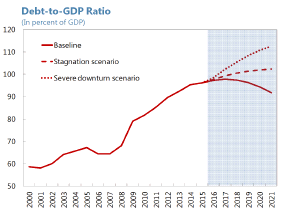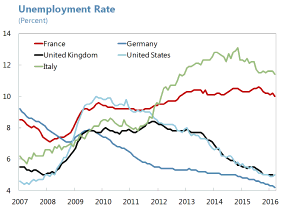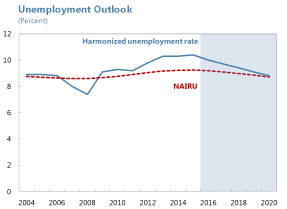France: Staff Concluding Statement of the 2016 Article IV Mission
May 24, 2016
A Concluding Statement describes the preliminary findings of IMF staff at the end of an official staff visit (or ‘mission’), in most cases to a member country. Missions are undertaken as part of regular (usually annual) consultations under Article IV of the IMF's Articles of Agreement, in the context of a request to use IMF resources (borrow from the IMF), as part of discussions of staff monitored programs, or as part of other staff monitoring of economic developments.
The authorities have consented to the publication of this statement. The views expressed in this statement are those of the IMF staff and do not necessarily represent the views of the IMF’s Executive Board. Based on the preliminary findings of this mission, staff will prepare a report that, subject to management approval, will be presented to the IMF Executive Board for discussion and decision.
France’s economy is recovering, but major efforts are still needed to foster job creation and put public finances on a more sustainable footing. The key concerns are high unemployment and public debt. Clearly, policies have progressed in recent years, notably through labor tax cuts and competition-enhancing structural reforms. The “loi El Khomri” is another necessary step toward a more dynamic labor market. There are also ongoing efforts to contain government spending while easing the tax burden. However, important structural barriers to job creation remain and high government spending is still an obstacle to fiscal sustainability. To bring about a faster and durable reduction in unemployment and debt, IMF staff recommends:
• Reversing the trend of rising public debt by limiting growth of government spending to the rate of inflation, as targeted in the government’s Stability Program. This could eventually make room for alleviating France’s heavy tax burden.
• Making spending more efficient at all levels of government to make fiscal consolidation sustainable and consistent with growth and social objectives. This should include efforts to streamline the civil service and extend means-testing of social benefits.
• Complementing recent labor market reforms by strengthening job search incentives through the unemployment and welfare benefit systems, and by further efforts to adapt education and training to the labor market.
• Easing regulations for start-ups and the self-employed, as envisaged in the draft “loi Sapin II”, while further opening up access to regulated professions to support a job-rich recovery.
• Encouraging banks and insurers to further adapt their business models in a global environment of low growth and interest rates, while monitoring emerging risks.
Where is the economy headed?
1. The economy is recovering, but not at a pace that will bring about the needed reduction in France’s high level of unemployment and public debt. Over past decades, growth has been supported by rising government spending, robust wage dynamics and productivity growth, and a steady expansion of the labor force. But the crisis has taken a toll, with unemployment increasingly entrenched at a high level and the public debt ratio still rising and approaching triple digits. With past drivers of aggregate demand fading and a still fragile euro area recovery, medium-term growth prospects are modest. Real GDP is expected to grow by close to 1.5 percent in 2016, and we project growth to average 1.75 percent over the coming five years. This would still leave output well below the level that would have been achieved on pre-crisis trends. Moreover, it assumes that no major economic shocks hit the economy, a prospect that should not be taken for granted. New episodes of stress in global financial markets, emerging economies, or protracted stagnation in the euro area would present serious policy challenges.
| Figure 1. Moderate Recovery and Modest Medium-Term Prospects | ||
 |
 | |
|
Sources: Haver Analytics and IMF staff calculations. | ||
How are reforms progressing?
2. In an environment with modest medium-term growth prospects at home and in the euro area, France faces two central policy challenges: (i) to support a more rapid creation of new private sector jobs and (ii) to ensure the sustainability of public finances via more efficient government spending. The authorities have made progress on both fronts in recent years, notably through the reduction in labor taxes under the Pacte de Responsabilité et de Solidarité (PRS) and CICE and the competition-enhancing structural reforms under the “loi Macron”. The loi El Khomri, currently in parliament, would be another step forward, increasing the scope for company-level labor agreements and reducing judicial uncertainty around dismissals. As for budget policies, there has been progress on efforts to contain spending at all levels of government while further easing taxes.
3. These are necessary and important steps. However, for a durable reduction in unemployment and debt, more will be needed. First, with unemployment increasingly structural, recent tax and labor reforms should be complemented with more measures to remove barriers to job creation. Second, it will be important to bring down the budget deficit further in order to ensure that debt, which is still rising, is placed on a firm downward trajectory. This consolidation should be based on deep reforms that make government spending much more efficient in order to safeguard important services and social protections. Finally, there is a need to support growth opportunities for start-ups and growing companies, and protect the health of the financial sector in a global environment of low growth and low inflation.
How to ensure fiscal sustainability?
4. Government spending fulfills many critical functions but over time it has grown so large that it is now at the heart of France’s fiscal difficulties. Real primary spending has outpaced real GDP over the past three decades, driving up public debt and necessitating repeated tax increases. At 57 percent of GDP, government spending is now one of the highest in Europe. After initially relying mostly on tax increases in the wake of the global financial crisis, the government has more recently pursued a consolidation strategy based entirely on spending efforts. However, the latter relied heavily on capping nominal expenditure growth and thus did not generate the hoped-for real savings when inflation and growth fell short.
| Figure 2. High and Rising Government Spending | ||
 |
 | |
|
Sources: French authorities, World Economic Outlook, and IMF staff calculations. | ||
5. The headline deficit is coming down, but the underlying fiscal effort has weakened. Aided by the recovery in growth and the decline in interest rates, the 2015 fiscal deficit declined to 3.6 percent of GDP. This was lower than budgeted, thanks to expenditure containment, especially at the local level, and measures to offset unforeseen new expenditures, including on security. However, abstracting from the effects of the cyclical recovery and interest savings, structural fiscal adjustment is slowing to near zero. As a result, we project that, without further efforts, France will just barely meet the 3 percent of GDP deficit target in 2017 and not reach the structural balance objective within the next five years. Debt is projected to peak at 98 percent in 2017, and decline only slowly thereafter.
6. The government’s fiscal consolidation plan could easily go off track in the event of shocks or implementation shortfalls. To achieve the medium-term goal of zero real spending growth, additional policy measures still need to be specified, in particular for the 2017 budget, and it is increasingly difficult to find offsets for any potential new spending needs. France’s fiscal path could also be thrown off course by new shocks that could push debt to well above 100 percent of GDP according to staff simulations. With virtually no room left for fiscal maneuver, it is important for France not to miss the opportunity to use the current economic upturn for strengthening efforts to rebuild fiscal buffers and healthy public finances.
| Figure 3. Slowing Fiscal Effort and Fragile Debt Dynamics | ||
 |
 | |
|
Sources: French authorities and IMF staff calculations. | ||
7. To anchor the needed fiscal consolidation, staff recommends limiting government spending growth to the rate of inflation, as broadly envisaged in the government’s latest Stability Program from 2017 onwards. To this end, deep reforms are needed to make spending much more efficient at all levels of government, so as to protect vital services and social support. This approach could help achieve an annual structural fiscal adjustment of about 0.5 percent of GDP—striking a reasonable balance between anchoring sustainability and limiting the impact on demand. It would accelerate progress toward the medium-term goal of structural fiscal balance, help place debt on a downward trajectory, and eventually make room for lowering France’s still heavy tax burden. IMF staff’s recently published study1 shows that efficiency-oriented reforms could yield major savings without weakening France’s social model.
• Streamlining the large civil service and limiting the wage drift at all levels of government would help reduce the wage bill, which at 13 percent of GDP is appreciably above the levels in EU peer countries.
• Increasing the targeting of social spending, for instance by expanding means-testing, could yield significant savings without adversely affecting social outcomes.
• While demographics and commendable reforms make France’s pension liabilities more manageable than in some other EU countries, there is still room to further increase the effective retirement age and rationalize special regimes.
• Slowing the growth in the cost of public health care, which already amounts to 8 percent of GDP, could be helped by further enhancing use of generic medicines, rationalizing hospital services and costs, and strengthening cost effectiveness evaluations.
After loi El Khomri—what else can be done to bring down unemployment?
8. Much of France’s high unemployment is structural, presenting a major social and economic challenge. Unemployment appears less responsive to the business cycle and is projected to come down only slowly over the medium term. Several factors seem to have made France’s labor market less adaptable to an evolving global economy—centralized labor agreements for over 700 branches; long and uncertain judicial procedures around dismissals; relatively easy access to unemployment and welfare benefits; a relatively high minimum wage; and a sizeable labor tax wedge. The adverse effects cut across the population but are particularly pronounced for the young, the low-skilled, and immigrants.
| Figure 4. Unemployment Entrenched at High Level | ||
 |
 | |
|
Sources: Haver Analytics and IMF staff calculations. | ||
9. The government has made reducing unemployment a central goal—and important steps have been taken. The labor tax wedge has been reduced significantly for low wage earners through the PRS and CICE. The loi Rebsamen has streamlined regulations for social dialogue in small and mid-sized companies and strengthened activity incentive schemes for lower wage earners. The loi Macron has taken a step toward reforming the labor arbitration system (prud’hommes). A new hiring subsidy for lower wage earners in small firms and a new training program for the unemployed were introduced earlier this year. Building on these reforms as well as the earlier labor law in 2013, the loi El Khomri would increase the scope for company-level labor agreements and further reduce judicial uncertainty around dismissals—these measures should encourage more hiring on open-ended contracts and improve labor market dynamics as the recovery gathers pace.
10. Important barriers to job creation remain, however. Certain aspects of the unemployment and welfare benefits systems may contribute to inactivity traps, with relatively easy qualification for benefits and weak job search incentives. Moreover, the education and training system has not kept up with a changing labor market, creating an increasing mismatch between the existing skills of the jobless and those sought by employers. Staff recommends:
• Reforming unemployment insurance rules to strengthen work incentives, including by (i) lengthening the minimum contribution period to qualify for unemployment insurance from the current four months; (ii) unifying the maximum unemployment benefit period to two years; (iii) changing the formula for calculating unemployment benefits to balance the treatment of part-time work and alternating short-term work contracts; and (iv) introducing “degressivity” of unemployment benefits.
• Strengthening job search support for unemployment and welfare benefit recipients, while tightening rules for accepting suitable job offers.
• Further improving education and professional training to match the skills of the young and unemployed to the needs of the labor market.
• Moving ahead with the government’s plan, under the “loi Sapin II”, to ease regulations for start-ups and the self-employed, enhance data transparency, and streamline qualification requirements for professions, while also further opening up regulated professions and enhancing the business simplification process.
Are France’s banks ready for protracted low growth and interest rates?
11. France’s global systemically important banks have buttressed their balance sheets since the global financial crisis, which has helped them cope with recent bouts of financial volatility. Capital and liquidity buffers have improved in line with tighter European regulations and global standards. France’s global banks have also reduced their leverage and their reliance on wholesale funding since the crisis, although for some it remains above peers. Profitability remains fragile, however.
12. The main challenge is for banks and insurers to operate in an era of modest growth and very low interest rates. While accommodative euro area monetary policy has lowered funding costs and supported the recovery, it has also flattened the yield curve, putting pressure on margins. Together with continued regulatory uncertainty, this will tend to constrain profitability of French and other European financial companies.
| Figure 5. Low Interest Environment a Challenge for Bank Profitability | ||
 |
 | |
|
Sources: SNL, Agence France Trésor, and IMF staff calculations. | ||
13. The financial sector will need to continue adapting to this environment, including through cost cutting and, possibly, consolidation within the euro area. At the same time, supervisors should remain vigilant with respect to potential emerging risks, including those related to search for yield. In addition, the macroprudential authority should further study the reasons for the significant increase in corporate debt in France and commercial real estate prices in greater Paris. Continuing the efforts to strengthen deposit insurance and bank resolution in Europe, together with steps to enhance bank data transparency, will help reduce systemic risks in the euro area. Finally, regulated savings rates in France should continue to be adapted to reflect market interest rate conditions.
The IMF mission would like to thank the authorities for the very constructive discussions.
1 Jean-Jacques Hallaert et Maximilien Queyranne, “From Containment to Rationalization: Increasing Public Expenditure Efficiency in France" IMF Working Paper No. 16/7, http://www.imf.org/external/pubs/ft/wp/2016/wp1607.pdf.
IMF COMMUNICATIONS DEPARTMENT |
| Media Relations |
|---|
| E-mail: media@imf.org |
| Phone: 202-623-7100 |







